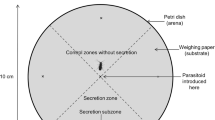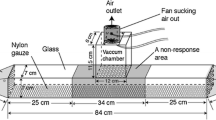Abstract
A short-chain α,β-unsaturated aldehyde, (E)-2-decenal, present in the defensive metathoracic gland ofNezara viridula (L.) (Heteroptera: Pentatomidae), stimulates a behavioral response in the egg parasitoidTrissolcus basalis (Woll.) (Hymenoptera: Scelionidae). Preliminary studies showed thatT. basalis are attracted to an area containing adultN. viridula, but we also found that femaleT. basalis would examine and probe glass beads coated with an acetone extract of the metathoracic gland from males or females. Using this bioassay, the kairomone was isolated by bioassay directed by preparative gas chromatography and identified by NMR and mass spectrometry as (E)-2-decenal. The biological activity of the identified aldehyde was compared with analogs to determine specificity. An unstable Z isomer was found to be more active but not present in detectable or behaviorly relevant levels in the host, based on the bell-shaped dose-response curve of the two isomers. An investigation was also designed to determine if theE isomer was also responsible for the egg recognition kairomone activity previously reported. However, no 2-decenal isomers were detected in host egg extracts and the chemical characteristics of the 2-decenal isomers differ from the unidentified egg recognition kairomone. The role of the (E)-2-decenal in attracting femaleT. basalts toN. viridula was demonstrated in a Y-tube olfactometer; this alk-2-enal appears to act as a long-range kairomone orientingT. basalis toNezara populations.
Similar content being viewed by others
References
Aldrich, J.R. 1988. Chemical ecology of the Heteroptera.Annu. Rev. Entomol. 33:211–238.
Bin, F., Vinson, S.B., andColazza, S. 1987. Responsiveness ofTrissolcus basalis (Woll.) (Hym: Scelionidae) female toNezara viridula (L.) (Het: Pentatomidae) in an olfactometer. Parasitoids insect.Colloq. INRA 48:15–16.
Bin, F., Vinson, S.B., Strand, M.R., Colazza, S., andJones, W.A. 1993. Source for an egg kairomone forTrissolcus basalis, a parasitoid ofNezara viridula.Physiol. Entomol. 18(1): 7–15.
Blum, M.S. 1981. Chemical Defenses of Arthropods. Academic Press, New York.
Brownlee, R.G., andSilverstein, R.M. 1968. Micro-preparative gas-chromatograph and modified carbon skeleton determinator.Anal. Chem. 13:2077–2079.
Clausen, C.P. 1978. Introduced parasites and predators of arthropod pests and weeds: A world review. USDA Agriculture Handbook 480. pp. 24–26.
Corey, E.I., andSuggs, J.W. 1975. Pyridinium chlorochromate. An efficient reagent for oxidation of primary and secondary alcohols to carbonyl compounds.Tetrahedron Lett. 1975:2647–2750.
Cumber, R.A. 1964. The egg parasite complex (Scelionidae: Hymenoptera) of shield bugs (Pen-tatomidae, Acanthosomidae: Heteroptera) in New Zealand.N.Z. J. Sci. 7:536–554.
Gilby, A.R., andWaterhouse, D.F. 1965. The composition of the scent of the green vegetable bug,Nezara viridula.Proc. R. Entomol. Soc. B, 162:105–120.
Harris, R.J. 1975. A Primer of Multivariate Statistic. Academic Press, New York. p. 98.
Jones, R.L. 1981. Chemistry of semiochemicals involved in parasitoid-host and predatorprey relationship, pp. 921–927,in D.A. Nordlund, R.L. Jones, and W.J. Lewis (eds.). Semiochemicals: Their Role in Pest Control. John Wiley & Sons, New York.
Jones, W.A. 1988. World review of the parasitoids of the green stink bug,Nezara viridula (L.) (Heteroptera: Pentatomidae).Ann. Entomol. Soc. Am. 75(2):262–273.
Kainoh, Y. 1990. Chemicals controlling the behavior of parasitoids and predators.In The Use of Natural Enemies to Control Agricultural Pests. FFTC Book Series 40. pp. 212–221.
Noldus, L.P.J.J. 1991. The Observer: A software system for collection and analysis of observa-tional data.Behav. Res. Methods, Instr. Comput. 23(3):415–429.
Orr, D.B. 1988. Scelionid wasps as biological control agents: A review.Fla. Entomol. 71(4):506–528.
Safavi, M. 1968. Etude biologique et écologique des Hyménoptères parasites des oeufs des punaises des céréales.Entomophaga 13:381–495.
Sales, F.M. 1979. Responsiveness and threshold for host-seeking stimulation of the femaleTris-solcus basalis (Woll) by the eggs of the hostNezara viridula (L.)Fitossanidade 3:36–39.
Sales, F.M., McLaughlin, J.R., andSailer, R.I. 1980. Quantitative analysis of the behavior patterns of the femaleTrissolcus basalis (Wollaston) when stimulated by the kairomonal extract of the host,Nezara viridula (L.)Fitossanidade, Fortaleza 4(1):43–50.
Siegel, S. 1956. Nonparametric Statistics for the Behavioral Science. McGraw-Hill, New York.
Vinson, S.B. 1985. The behavior of parasitoids, pp. 417–469,in G.A. Kerkut and L.I. Gilbert (eds.). Comprehensive Insect Physiology, Biochemistry and Pharmacology, Vol 9. Pergamon Press, Elmsford, New York.
Wadsworth, W.S., andEmmory, W.D. 1973. Pages 547–549,in H.E. Baumgartner (ed.). Organic Syntheses Colloquium, Vol. V. John Wiley and Sons, New York.
Author information
Authors and Affiliations
Rights and permissions
About this article
Cite this article
Mattiacci, L., Vinson, S.B., Williams, H.J. et al. A long-range attractant kairomone for egg parasitoidTrissolcus basalis, isolated from defensive secretion of its host,Nezara viridula . J Chem Ecol 19, 1167–1181 (1993). https://doi.org/10.1007/BF00987378
Received:
Accepted:
Issue Date:
DOI: https://doi.org/10.1007/BF00987378




